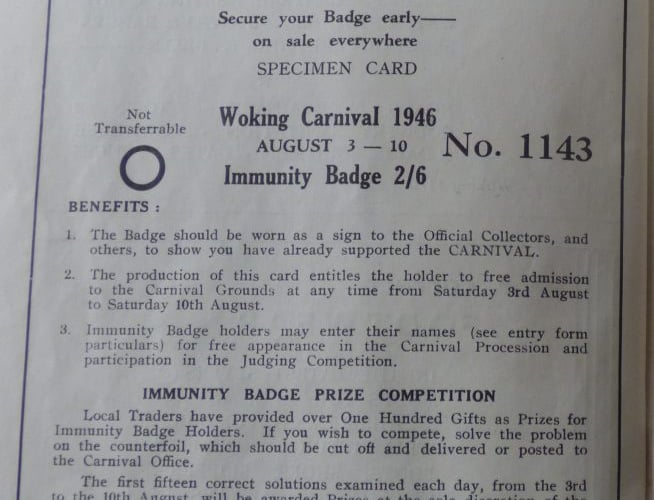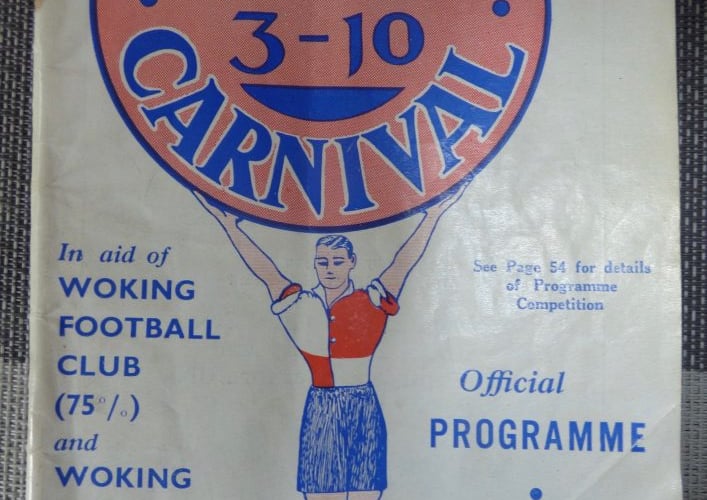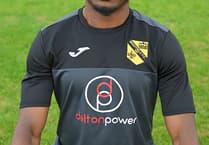A BADGE of privilege for people supporting Woking’s 1946 carnival has been discovered as far away as Canada. But how it got there is a mystery.
Diane Zilowsky said in an email to Peeps: “I recently came across this lapel pin while sorting through old boxes from my parents’ home. In a quest to find out more about it, I came across your article about the 1946 carnival online, first published in the News & Mail on 2 August 2020.
“I have been unable to locate any information on its significance. It is one inch in diameter, has a slightly domed shape and there’s a pin on the back. It is in perfect condition albeit very slightly yellowed.”
Our story last August was based on details in the carnival programme, a copy of which was bought at an antiques fair by reader Ron Raggett. The carnival raised funds for Woking Football Club and Woking Victoria Hospital.
The discovery of the lapel badge prompted a further look at the carnival’s programme, which gives details of the badge. It was named the Immunity Badge. Ahead of the carnival that ran from 3-10 August that year, people could buy a badge for two shillings and six pence.

Benefits to the purchaser were listed in the programme.
It said: “The badge should be worn as a sign to the Official Collectors and others, to show you have already supported the carnival.
“The production of this card entitles the holder to free admission to the Carnival Grounds at any time from Saturday 3rd August to Saturday 10th August. 3
“Immunity Badge holders may enter their names for free appearance in the Carnival Procession and participation in the Judging Competition.”
The programme also noted that local traders had provided more than 100 gifts as prizes for Immunity Badge holders.
Donors and the prizes the provided included: Philpotts, a skirt. DP Waters, 4lb jar of Lewer’s Herbal Tablets. EJ Talbot, non-utility lighter. Leigh’s Service Garage, one pair of 450 x 17 tyres (remoulded). JD Brewer, shaving brush and razor. Elsie’s, two dresses. Belfast Linen Warehouse, plastic cushion. GS Addison, your fountain pen kept filled for 12 months.
Diane does not know how the badge came to be in Canada. She said: “I have no idea where it came from. Nor does my mother. While her father was from Norfolk, he did not pay a return visit to England after he married in 1919.

“My father spent some of his time as a soldier in England during the Second World War but only pending deployment to Normandy. He did not return to Britain before he came back to Canada in 1945. So it’s a mystery how it came to be in a box on an acreage near Humboldt, Saskatchewan.
“The badge has no sentimental value to my family and I would love to see it preserved along with your stories. If you could find an appropriate home for it in Woking, I would be more than pleased to send it to you.”
Following further correspondence with Diane, we can reveal the badge will soon be on its way to The Lightbox for safe keeping in the museum’s Woking collection.
And it begs the question – does anyone else have a Woking Carnival 1946 Immunity Badge?
If you have some memories or old pictures relating to the Woking area, call me, David Rose, on 01483 838960, or drop a line to the News & Mail.
David Rose is a local historian and writer who specialises in what he calls “the history within living memory” of people, places and events in the west Surrey area covering towns such as Woking and Guildford. He collects old photos and memorabilia relating to the area and the subject, and regularly gives illustrated local history talks to groups and societies. For enquiries and bookings please phone or email him at: [email protected]

.jpeg?width=209&height=140&crop=209:145,smart&quality=75)
-receives-the-Managers-Player-of-the-Season-award-from-TJ-Barbato-(Photo-Dan-Eicke).jpeg?width=209&height=140&crop=209:145,smart&quality=75)

